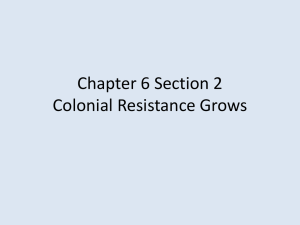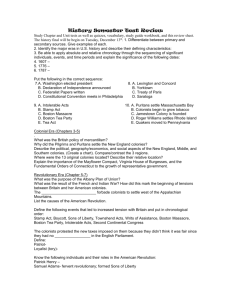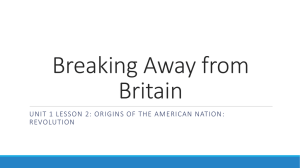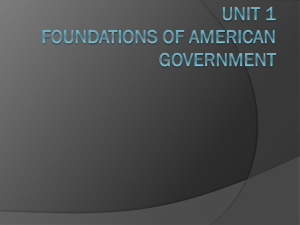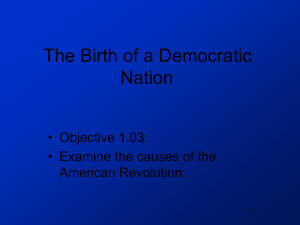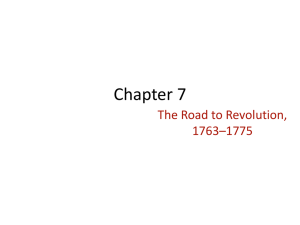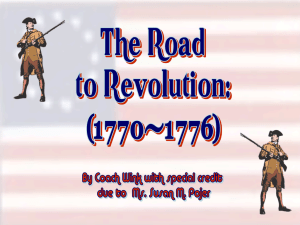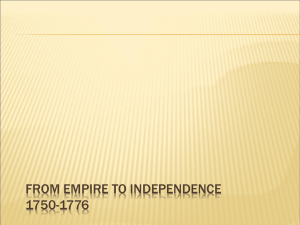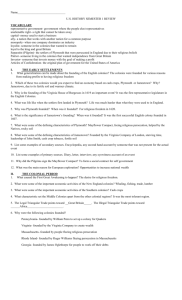revolution powerpoint
advertisement
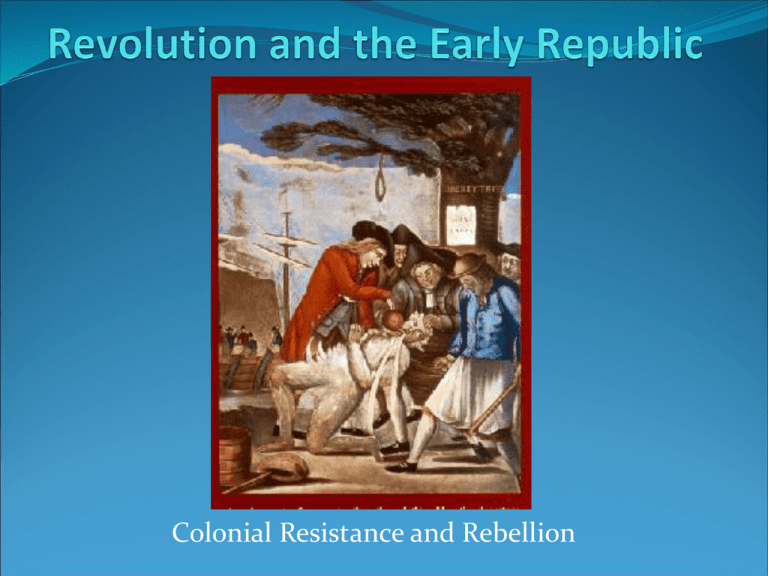
Colonial Resistance and Rebellion England is in Debt The French and Indian War cost way, way too much money. England started taxing the American Colonies to pay the debt back. They also started tightening control over the colonies. The Colonies get Upset! Sugar Tax, Stamp Tax (tax on all types of paper goods) Colonies upset – they felt that it was unfair to be forced to pay a tax without having representation in Parliament. The Colonies get Upset (cont.) Colonists began to protest and boycott all the paper goods – it worked, England repealed the Stamp Tax. Then, England passed the Townsend Acts – tax on glass, lead, tea and other goods. Colonists boycotted again, it worked again, England repealed the taxes – except on tea. Things Start to Happen Boston Massacre – a bunch of colonists are killed while harassing British soldiers. Boston Tea Party – in protest of the Tea Act, a bunch of colonists dump English tea in the harbor. England Tightens Control Intolerable Acts – punishment for the Boston Tea Party Closed Boston Harbor Quartering Act – forced people to let soldiers stay in their homes Placed Boston under military control Made some gun ownership illegal Lexington and Concord British troops march to from Boston to Concord to capture a supply of rifles. 70 Colonists ambushed them in Lexington and open fire (only 1 British soldier died). On the way back they are ambushed by over 3000 colonists (LOTS British soldiers die). Colonies Raise an Army Second Continental Congress (the group of colonial leaders) decide to raise a militia (army) and select George Washington as the commander. More Trouble in Boston Colonial Militia and tries to free Boston. Battle of Bunker Hill (over 1000 British soldiers die). Colonials capture Boston. British Navy blockades Boston Harbor. Moving Toward Independence Ideas of John Locke – Enlightenment Philosopher Believed that people were born with natural rights (life, liberty, property). It is the government’s responsibility to protect people’s rights. If a government does not, then people have the right to rebel against that government! …Toward Independence (cont.) Common Sense – pamphlet/essay written by Thomas Paine. Written to promote rebellion against English rule (chance to create a new society, better control over trade, etc.). Declaration of Independence Colonists finally decide that they should fight to become a new nation (not just to earn better treatment from England). Now all they had to do was win the war! The War for Independence Opposing Sides For Independence For English Control Patriots – colonists fighting English Soldiers for against England. Help and money from the French, Dutch, Polish. Hessians (hired mercenaries from Germany). Loyalists – colonists who were loyal to the King. The War Patriots lost many battles early on. The first major battle we won was the Battle of Saratoga – which convinced France to help. After five years of fighting, the British surrendered after the Battle of Yorktown (1781). Why the Colonies Won Colonial soldiers fought hard to defend their homes. Colonial soldiers knew the land better (used guerilla tactics). The British made several mistakes. The war was unpopular in England, cost too much money… so they decided to stop fighting. Treaty of Paris (1783) Officially ended the war. Confirmed that the Colonies were independent. Set the boundaries of the new nation. Confederation and Constitution Articles of Confederation Now that they were independent, the colonies had to make a government. Articles of Confederation – created a WEAK central government with little cooperation among the states. Weaknesses of the Articles of Confederation Could not collect taxes from the states. Each state had one vote (regardless of size). 9 out of 13 states had to agree to pass laws. No executive branch. No national court system. Could not regulate interstate commerce (business). Northwest Ordinance of 1787 Plan for settling the Northwest Territory. Would create 3-5 new states (ignored the rights of Native Americans). This was the only successful thing that was accomplished by the Articles of Confederation. Shay’s Rebellion Massachusetts farmers protested increased state taxes. Protests became a riot, state militia ended up killing some farmers. Scared all of the colonies – people decided that a stronger government was needed to solve the county’s problems. Constitutional Convention Meeting of colonial leaders to discuss a plan to fix the Articles of Confederation. They ended up creating a whole new form of government: Federalism – system where the central (federal) government shares power with the states. Conflict over Representation Large states wanted representation in congress based on population. Small states wanted each state to be represented equally. Great Compromise – two houses of congress: one based on population (House of Representatives), one with equal representation (Senate). Conflict over Slaves Southern states wanted slaves to be counted for representation. Northern states did not want them counted. Three-Fifths Compromise – they agreed that a slave would be counted as 3/5ths of a person for representation (and taxing). Separation of Powers Legislative Branch – makes the laws. Executive Branch – enforces the laws. Judicial Branch – interprets the laws and settles disputes. Checks and balances – each branch can prevent the others from becoming too powerful. Ratifying the Constitution Federalists – favored the Constitution. Anti-federalists – against the Constitution. Bill of Rights – first 10 Amendments that guaranteed people’ individual rights – protected against government becoming too powerful. Launching the New Nation Washington is President Judiciary Act of 1789 – created the Supreme Court (and other federal courts). Cabinet – the president’s main advisors. Secretary of State – Thomas Jefferson Secretary of War – Henry Knox Secretary of Treasury – Alexander Hamilton Political Differences Alexander Hamilton Thomas Jefferson Favored strong federal Favored states having more government Favored business interests Loose interpretation of the Constitution power – “states rights” Favored farming interests Strict interpretation of the Constitution FEDERALISTS DEMOCRATIC- REPUBLICANS Problems Facing the Nation Financial problems (debt from the Revolution) Created the National Bank. Protective Tariffs– taxes on imported goods (designed to encourage local production). Foreign Affairs stayed neutral in conflict between England and France. Conflict over the National Bank Federalists felt that it was necessary to manage the nation’s economy. Anti-federalists felt that it was unconstitutional (the constitution didn’t give the federal government the right to do it). John Adams is President Adams was a Federalist Alien and Sedition Acts – Extended the length it took for immigrants to become citizens to 14 years. Made it illegal to make statements against the US government. Nullification – principle that says that states can nullify/ignore any law that they believe is unconstitutional (it never became a law). Inspired by the Virginia and Kentucky Resolutions
